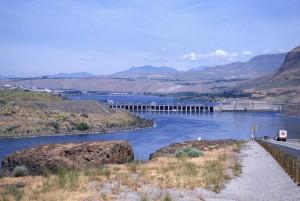 Last week The Oregonian reported that wind energy farms connected with the Bonneville Power Administration’s transmission network had, for the first time, generated more power than the BPA’s hydroelectric power system. While the result of several converging factors—including a hydropower system operating below full capacity, and the rapid increase of wind generation facilities linked to the BPA system—it represents a milestone in efforts in the Pacific Northwest region to diversify renewable energy resources beyond large hydro.
Last week The Oregonian reported that wind energy farms connected with the Bonneville Power Administration’s transmission network had, for the first time, generated more power than the BPA’s hydroelectric power system. While the result of several converging factors—including a hydropower system operating below full capacity, and the rapid increase of wind generation facilities linked to the BPA system—it represents a milestone in efforts in the Pacific Northwest region to diversify renewable energy resources beyond large hydro.
It is difficult to overstate the importance of hydropower, and of the BPA network, in the Pacific Northwest. Hydropower accounts for 73 percent of electricity production in Washington, which also leads U.S. states in hydropower and produced 29 percent of U.S. net electricity generation in 2011, according to the U.S. Energy Information Administration. Oregon is the second largest hydropower-producing state, after Washington, and hydro accounted for 80 percent of Oregon’s net power generation in 2011. BPA generates approximately one-third of all electricity consumed in the region; the Grand Coulee Dam alone has a total generating capacity of 6,809 megawatts. The low cost of electricity generated by the vast hydroelectric system–among the lowest in the United States–has for decades been an important factor in the region’s economic growth and development. In recent years, Oregon and Washington communities close to hydropower facilities have become magnets for massive new cloud computing facilities.
The long-term sustainability of this system is, however, no longer taken for granted. During the last decade, Washington and Oregon have implemented renewable portfolio standards programs aimed at increasing energy generated from green and renewable resources while diversifying away from the large hydro resources on which the states currently depend. These have been driven in part by efforts to balance electricity and irrigation needs, as torrid regional growth continues, with initiatives to save rapidly vanishing salmon runs in the Columbia, Snake, and other major rivers that have long powered the region. There is no question that large hydropower will remain central to the region’s energy generation, but its future is inextricably intertwined with these factors, not to mention the potential disruptions of climate change effects on the region’s weather patterns. These make the diversification of renewable energy resources in the states’ portfolio increasingly imperative.
While wind power currently accounts for a small fraction of energy generation in the Pacific Northwest, it is rapidly scaling up. Oregon now has the fourth-largest wind power generation capacity in the United States, according to the American Wind Energy Association, and Washington the seventh-largest. Its continued growth also faces challenges, however, in the form of environmental concerns, the cost of scaling, and managing problems of electricity oversupply and reliability. Nevertheless, that wind has already reached a level where it could surpass hydropower, even if briefly, marks an important step forward in ensuring that green, sustainable resources will continue to power the region’s future energy needs.
Image Source

